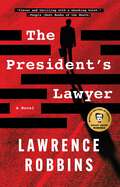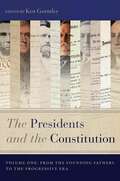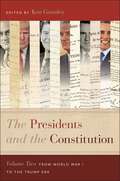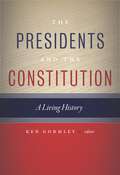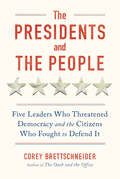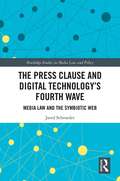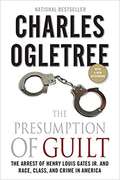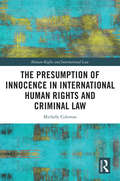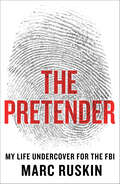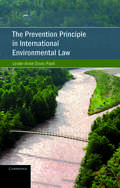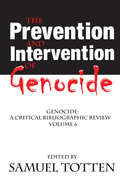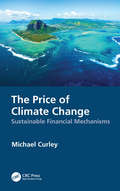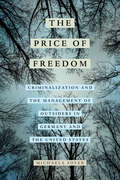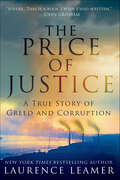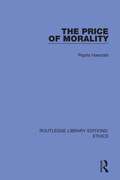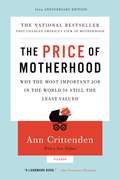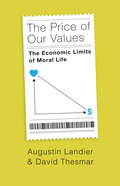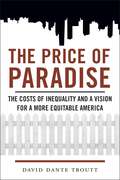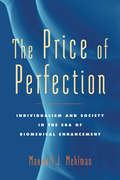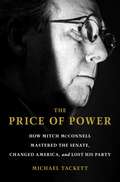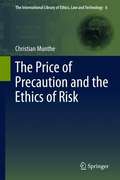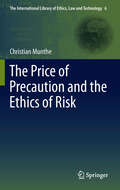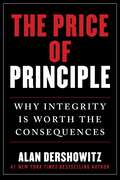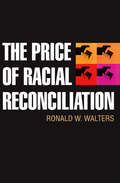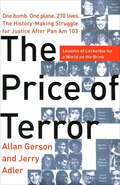- Table View
- List View
The President's Lawyer: A Novel
by Lawrence RobbinsA Washington, DC, litigator is hired to defend his best friend, the former President of the United States, against a murder charge in this novel that is &“clever and thrilling with a shocking twist&” (People).After a long career as one of DC&’s most powerful litigators, Rob Jacobson is faced with the case of a lifetime: the former President of the United States—his childhood best friend—has been accused of murdering his mistress. Rob knows he&’s the only one who can prove his friend&’s innocence, but he is soon overwhelmed as he attempts to devise a strategy to defend an authoritative man with a taste for infidelity, serious anger issues, and unconventional sexual appetites. As the high-profile case unfurls, the troubled, intertwining pasts of the two men complicate Rob&’s efforts and soon, doubts begin to grow in his head. Could his oldest friend truly be capable of murder or is something even darker at play? &“Robbins...keeps the pace fast and the courtroom scenes convincing&” (The New York Times Book Review) in this sensational thriller by a true DC legal insider.
The Presidents and the Constitution, Volume One: From the Founding Fathers to the Progressive Era
by Ken GormleyShines a light on the constitutional issues that confronted and shaped each presidency from George Washington to the Progressive EraDrawing from the monumental The Presidents and the Constitution: A Living History, published in 2016, the nation’s foremost experts in the American presidency and the US Constitution join together to tell the intertwined stories of how the first twenty-seven distinctive American presidents have confronted and shaped the Constitution and thus defined the most powerful office in human history.From George Washington to William Howard Taft, The Presidents and the Constitution, Volume 1 illuminates the evolving American presidency in a unique way—through the lens of the Constitution itself. Arranged chronologically by president, the book examines the constitutional issues confronting each president in the context of the personalities driving historical events.The contributors illustrate the extensive powers of the American presidency in domestic and foreign affairs, showing how they have been used by the men who were granted them, and brings to light the overarching constitutional themes that span this country’s history and tie each presidency to the other branches of government.
The Presidents and the Constitution, Volume Two: From World War I to the Trump Era
by Ken GormleyA revealing look at the constitutional issues that confronted and shaped each presidency from Woodrow Wilson through Donald J. TrumpDrawing from the monumental publication The Presidents and the Constitution: A Living History in 2016, the nation’s foremost experts in the American presidency and the US Constitution tell the intertwined stories of how the last eighteen American presidents have interfaced with the Constitution and thus defined the most powerful office in human history.This volume leads off with Woodrow Wilson, the president who led the nation through World War I, and ends with Donald J. Trump, who ushered the US into uncharted political and legal territory. In between, the country was confronted with international wars, the civil rights movement, 9/11, and the advent of the internet, all of which presented unique and pressing constitutional issues. The last one hundred years reveals the awesome powers of the American presidency in domestic and foreign affairs, illustrating how they have stood up to modern and novel legal challenges. The Presidents and the Constitution is for anyone interested in a captivating and illuminating account of one of the most compelling subjects in our American democracy.
The Presidents and the Constitution: A Living History
by Ken GormleyHow forty-four presidents have shaped power and the law: &“Everything you ever wanted to know about the Supreme Court and the Presidency but were afraid to ask.&” —Nina Totenberg, NPR legal affairs correspondent In this sweepingly ambitious volume, the nation&’s foremost experts on the American presidency and the U.S. Constitution join together to tell the intertwined stories of how each American president has confronted and shaped the Constitution. From the first president to the forty-fourth, each occupant of the office has contributed to the story of the Constitution through the decisions he made and the actions he took as the nation&’s chief executive. By examining presidential history through the lens of constitutional conflicts and challenges, The Presidents and the Constitution offers a fresh perspective on how the Constitution has evolved in the hands of individual presidents. It delves into key moments in American history, from Washington&’s early battles with Congress to the advent of the national security presidency under George W. Bush and Barack Obama, to reveal the dramatic historical forces that drove these presidents to action. Historians and legal experts, including Richard Ellis, Gary Hart, Stanley Kutler, and Kenneth Starr, bring the Constitution to life, and show how the awesome powers of the American presidency have been shaped by the men who were granted them. The book brings to the fore the overarching constitutional themes that span this country&’s history—and ties together presidencies in a way never before accomplished. &“An evenhanded consideration of each president&’s operating style and effectiveness . . . top-drawer contributors.&” ―Kirkus Reviews &“Ken Gormley and forty-four writers on all our presidents have connected the Constitutional dots brilliantly, demonstrating the immense concentration of power in the chief executive and the different, often contradictory, ways it has been used or misused. The book is a class in Constitutional Law all by itself.&” —Bob Woodward
The Presidents and the People: Five Leaders Who Threatened Democracy and the Citizens Who Fought to Defend It
by Corey BrettschneiderAmerican presidents have often pushed the boundaries established for them by the Constitution; this is the inspirational history of the people who pushed back. Imagine an American president who imprisoned critics, spread a culture of white supremacy, and tried to upend the law so that he could commit crimes with impunity. In this propulsive and eminently readable history, constitutional law and political science professor Corey Brettschneider provides a thoroughly researched account of assaults on democracy by not one such president but five. John Adams waged war on the national press of the early republic, overseeing numerous prosecutions of his critics. In the lead-up to the Civil War, James Buchanan colluded with the Supreme Court to deny constitutional personhood to African Americans. A decade later, Andrew Johnson urged violence against his political opponents as he sought to guarantee a white supremacist republic after the Civil War. In the 1910s, Woodrow Wilson modernized, popularized, and nationalized Jim Crow laws. In the 1970s, Richard Nixon committed criminal acts that flowed from his corrupt ideas about presidential power. Through their actions, these presidents illuminated the trip wires that can damage or even destroy our democracy. Corey Brettschneider shows that these presidents didn’t have the last word; citizen movements brought the United States back from the precipice by appealing to a democratic understanding of the Constitution and pressuring subsequent reform-minded presidents to realize the promise of “We the People.” This is a book about citizens—Frederick Douglass, Ida B. Wells, Daniel Ellsberg, and more—who fought back against presidential abuses of power. Their examples give us hope about the possibilities of restoring a fragile democracy.
The Press Clause and Digital Technology's Fourth Wave: Media Law and the Symbiotic Web (Routledge Studies in Media Law and Policy)
by Jared SchroederDuring the first part of the twenty-first century, bloggers, citizen journalists, social media users, Yelp reviewers, and a myriad of other communicators have found themselves facing defamation, privacy, campaign finance, and other lawsuits as a result of the messages they have communicated. In many ways, these communicators are facing legal questions that are similar to what traditional journalists have faced for centuries regarding their rights to gather and publish information. This book examines how the press clause, a First Amendment freedom with no agreed-upon definition, can be understood in order to help guide the courts and twenty-first-century publishers regarding protecting expression as we move into the fourth wave of networked communication, an era that will be defined by increasingly complex relationships between humans and artificially intelligent communicators. To do so, the book draws upon the discourse theory of communication in democratic society, the legal and foundational history of the press clause, lower-court cases that involve citizen publishers who have claimed protections that have historically been associated with traditional journalism, and established legal and scholarly examinations of artificial intelligence to ultimately construct a framework for how the press clause can be reimagined to protect older and newer generations of publishers.
The Presumption of Guilt: The Arrest of Henry Louis Gates, Jr. and Race, Class and Crime in America
by Charles OgletreeShortly after noon on Tuesday, July 16, 2009, Henry Louis Gates, Jr., MacArthur Fellow and Harvard professor, was mistakenly arrested by Cambridge police sergeant James Crowley for attempting to break into his own home. The ensuing media firestorm ignited debate across the country. The Crowley-Gates incident was a clash of absolutes, underscoring the tension between black and white, police and civilians, and the privileged and less privileged in modern America. <p><p> Charles Ogletree, one of the country's foremost experts on civil rights, uses this incident as a lens through which to explore issues of race, class, and crime, with the goal of creating a more just legal system for all. Working from years of research and based on his own classes and experiences with law enforcement, the author illuminates the steps needed to embark on the long journey toward racial and legal equality for all Americans.
The Presumption of Innocence in International Human Rights and Criminal Law (Human Rights and International Law)
by Michelle ColemanThis book provides a comprehensive analysis of the presumption of innocence from both a practical and theoretical point of view. Throughout the book a framework for the presumption of innocence is developed. The book approaches the right to presumption of innocence from an international human rights perspective using specific examples drawn from international criminal law. The result is a framework for understanding the right that is grounded in human rights law. This framework can then be applied across different national and international systems. When applied, it can help determine when the presumption of innocence is being infringed upon, eroded, violated, and ensure that the presumption of innocence is protected. The book is an essential resource for students, academics and practitioners working in the areas of human rights, criminal law, international criminal law, and evidence. The themes also have a more general application to national jurisdictions and legal theory.
The Pretender: My Life Undercover for the FBI
by Marc RuskinOf all the tools available to law enforcement, the living, breathing undercover operative remains the gold standard. This is true in TV shows and in the real world. In the era of electronic surveillance, UC work enforces accountability; it prevents mistakes, and of all the boots on the ground, undercover agents are often the most valuable. The FBI generally has about 100 UC agents working full-time in the field. In the 1990s and 2000s, Marc Ruskin had the most diverse, and notorious, case list of all, and the broadest experience within the bureaucracy, including overseas. He worked ops targeting public corruption, corporate fraud, Wall Street scams, narcotics trafficking, La Cosa Nostra, counterfeiting—and gritty street-level scams and schemes. Sometimes working three or four cases simultaneously, Ruskin switched identities by the day: Each morning he had to walk out the door with the correct ID, clothes, accessories and frame of mind for that day’s mission. Meet Alex Perez, Alejandro Marconi, and Sal Morelli, just a few of Ruskin’s undercover personas.And how is the right UC agent chosen, how is a bogus identity manufactured and “backstopped,” how is the Bureau's long-term con painstakingly assembled? No one has ever given us the inside story like Ruskin. The Pretender is the definitive narrative of undercover ops—the procedures, the successes, the failures--and the changes in the culture of the new-era FBI.
The Prevention Principle in International Environmental Law (Cambridge Studies On Environment, Energy And Natural Resources Governance )
by Duvic-Paoli Leslie-AnnePrevention is recognized as a cornerstone of international environmental law, but this principle remains abstract and elusive in terms of exactly what is required of states to prevent environmental harm. <P><P>In this illuminating work, Leslie-Anne Duvic-Paoli addresses this issue by offering a systematic, comprehensive assessment in which she clarifies the rationale, content, and scope of the prevention principle while also placing it in a wider legal context. <P>The book offers a detailed analysis of treaty law, custom codification works, and case law before culminating in a conceptualization of prevention based on three definitional traits: 1. Its anticipatory rationale; 2. Its due diligence content; and 3. Its wide spatial scope to protect the environment as a whole. This book should be read by anyone seeking to understand the evolving principle of prevention in international environmental law, and how it increasingly shares common ground with reparation in the arena of compliance control.<P> Provides a systematic and up-to-date treatment of the principle of prevention, widely considered to be the cornerstone of international environmental law.<P> Undertakes a comprehensive review of the manifestations of prevention in conventional law, custom codification works, and case law.<P> Seeks to understand prevention, and its evolution, in the context of general international law trends.
The Prevention and Intervention of Genocide: An Annotated Bibliography (Critical Bibliographic Review Ser.)
by Samuel TottenOver the last twenty years the world has witnessed four major genocides. There was the genocide in Iraq (1988), in Rwanda (1994), in Srebrenica (1995), and in Darfur (2003 and continuing). Most observers agree there is an urgent need to assess the international community's efforts to prevent genocide and to intervene (once a genocide is under way) in an effective and timely manner. This volume, the latest in a widely respected series on the subject of genocide, provides an overview of a host of issues germane to this task. The book begins with a cogent discussion of the issues of prevention and intervention during the Cold War years. The second chapter discusses the abject failures and moderate (though, in some cases, highly controversial) successes at prevention and intervention carried out in the 1990s and early 2000s. Further chapters examine latest efforts to develop an effective genocide early warning system and examine the complexity of and barriers to prevention. The pros and cons of sanctions and the problems of enforcement and evaluation their effectiveness are then discussed. Conflicts between state sovereignty and the protection of threatened populations are examined both in historical context and by incorporating the latest thinking. Later chapters treat the issue of intervention; why and how it has met with only limited success. Concentrating on Rwanda and Srebrenica, chapter 8 discusses various peace operations that were abject failures and those that were moderately successful. The concept of an anti-genocide regime is examined in terms of progress in developing such a regime as well as what the international community must do in order to implement it. Chapters discuss key issues related to post-genocidal periods, those that need to be addressed in order to establish stability in a wounded land and populace as well as to prevent future genocides. The final chapter asks whether bringing perpetrators to justice has any impact in breaking impunity, ensuring deterrence, and bringing about reconciliation. The contributors to the volume are all noted scholars, some of whom specialize in the study of genocide, and others who specialize in such areas as early warning, peacekeeping, and sanctions.
The Price of Climate Change: Sustainable Financial Mechanisms
by Michael CurleyThe Price of Climate Change: Sustainable Financial Mechanisms presents a summary of the effects of global warming with specific emphasis on what these phenomena will cost and the price we must pay for trying to mitigate these processes. Some of these mitigation strategies include reducing our use of carbon by converting to non-carbon energy sources such as solar, wind, and nuclear, or lower-carbon sources such as natural gas. The book examines the financial implications of society adapting to the effects of climate change, including rising sea levels, extreme weather events, and desertification. Further, it addresses the costs to make buildings more resilient to climate change, such as flood considerations, improving durability against severe weather, bolstering insulation, and more. Sources of funding for any type of environmental projects, including those for climate change mitigation, are also examined. These include governmental budgets at the federal, state, and local levels, international development banks, international capital markets, and private funds. Features: Addresses global climate change issues from the standpoints of mitigation, adaptation, and resilience and the funding mechanisms for each. Describes different types of energy sources as well as their respective costs, including nuclear, solar, natural gas, and more. Examines the effects of agriculture on climate change as well as the potential ways it can be used to help mitigate the issue. The book’s straightforward approach will serve as a useful guide and reference for practicing professionals and can also be appreciated by the general public interested in climate change issues and mitigation strategies.
The Price of Freedom: Criminalization and the Management of Outsiders in Germany and the United States
by Michaela SoyerA free ebook version of this title is available through Luminos, University of California Press's Open Access publishing program. Visit www.luminosoa.org to learn more. Seeking to shed light on how we might end mass incarceration, The Price of Freedom compares the histories and goals of the American and German justice systems. Drawing on repeated in-depth interviews with incarcerated young men in the United States and Germany, Michaela Soyer argues that the apparent relative lenience of the German criminal justice system is actually founded on the violent enforcement of cultural homogeneity at the hands of the German welfare state. Demonstrating how both societies have constructed a racialized underclass of outsiders over time, this book emphasizes that criminal justice reformers in the United States need to move beyond European models in order to build a truly just, diverse society.
The Price of Justice: A True Story of Greed and Corruption
by Laurence LeamerA nonfiction legal thriller that traces the fourteen-year struggle of two lawyers to bring the most powerful coal baron in American history, Don Blankenship, to justiceDon Blankenship, head of Massey Energy since the early 1990s, ran an industry that provides nearly half of America's electric power. But wealth and influence weren't enough for Blankenship and his company, as they set about destroying corporate and personal rivals, challenging the Constitution, purchasing the West Virginia judiciary, and willfully disregarding safety standards in the company's mines—in which scores died unnecessarily.As Blankenship hobnobbed with a West Virginia Supreme Court justice in France, his company polluted the drinking water of hundreds of citizens while he himself fostered baroque vendettas against anyone who dared challenge his sovereignty over coal mining country. Just about the only thing that stood in the way of Blankenship's tyranny over a state and an industry was a pair of odd-couple attorneys, Dave Fawcett and Bruce Stanley, who undertook a legal quest to bring justice to this corner of America. From the backwoods courtrooms of West Virginia they pursued their case all the way to the U.S. Supreme Court, and to a dramatic decision declaring that the wealthy and powerful are not entitled to purchase their own brand of law.The Price of Justice is a story of corporate corruption so far-reaching and devastating it could have been written a hundred years ago by Ida Tarbell or Lincoln Steffens. And as Laurence Leamer demonstrates in this captivating tale, because it's true, it's scarier than fiction.
The Price of Morality
by Pepita HaezrahiOriginally published in 1961, this book defines the specific traits and describes the concrete qualities of moral action. It denotes the boundaries and discusses the conflicts which arise between the aims of moral goodness and those of pure religiosity, personal and historic grandeur and creative excellence. The theories of theologians like Barth and Brunner among others, and the maximalist theories of Nietzsche and his disciples and certain existentialists are contrasted with Kant’s essay on pure ethics.
The Price of Motherhood: Why the Most Important Job in the World Is Still the Least Valued
by Ann CrittendenTHE 10TH ANNIVERSARY EDITION OF THE NATIONAL BESTSELLER THAT CHANGED AMERICA'S VIEW OF MOTHERHOOD In the pathbreaking tradition of Backlash and The Second Shift, this provocative book shows how mothers are systematically disadvantaged and made dependent by a society that exploits those who perform its most critical work. Drawing on hundreds of interviews and research in economics, history, child development, and law, Ann Crittenden proves definitively that although women have been liberated, mothers have not. Bold, galvanizing, and full of innovative solutions, The Price of Motherhood was listed by the Chicago Tribune as one of the Top Ten Feminist Literary Works since the publication of Betty Friedan's Feminine Mystique. This "bracing call to arms" (Elle) offers a much-needed accounting of the price that mothers pay for performing the most important job in the world.
The Price of Our Values: The Economic Limits of Moral Life
by Augustin Landier David ThesmarThe economic case for self-interest at the outer limits of being morally good. Modern life is an exercise in discomfort. In the face of endless injustice, how much selfishness is permissible? How do we square suffering elsewhere with our hope to thrive at home? How does one strive for the greater good while guarding one's personal interests? The Price of Our Values argues that the answers to these questions are economic: by weighing our sense of the personal costs associated with the outer limits of our moral beliefs. These tradeoffs—the want to be good, the personal costs of being good, and the points at which people abandon goodness due to its costs—are somewhat unsettling. But as economists Augustin Landier and David Thesmar show, they are highly predictable, even justified. Our values guide us, but we are also forced to consider economic costs to settle decisions. The Price of Our Values is an economic reckoning with the universal unease of contemporary moral life. Wielding insights from the philosophical founders of the field, Landier and Thesmar provide frameworks for thinking about the place of values—justice, freedom, beauty— in the decisions of modern life. They do so in terms that seek to be consistent with both our good intentions and their limits.
The Price of Paradise: The Costs of Inequality and a Vision for a More Equitable America
by David Dante TrouttAmerican communities are facing chronic problems: fiscal stress, urban decline, environmental sprawl, mass incarceration, political isolation, disproportionate foreclosures and severe public health risks. In The Price of Paradise, David Troutt argues that it is a lack of mutuality in our local decision making that has led to this looming crisis facing cities and local governments. Arguing that there are structural flaws in the American dream, Troutt investigates the role that place plays in our thinking and how we have organized our communities to create or deny opportunity. Legal rules and policies that promoted mobility for most citizens simultaneously stifled and segregated a growing minority by race, class and—most importantly—place. A conversation about America at the crossroads, The Price of Paradise is a multilayered exploration of the legal, economic and cultural forces that contribute to the squeeze on the middle class, the hidden dangers of growing income and wealth inequality and the literature on how growth and consumption patterns are environmentally unsustainable.
The Price of Perfection: Individualism and Society in the Era of Biomedical Enhancement (Bioethics)
by Maxwell J. MehlmanFew would question the necessity of artificial limbs for amputees. But what of surgery to lengthen the legs of children who are merely shorter than average? Hardly anyone would challenge the decision to prescribe Aricept to people with dementia. But is it acceptable to give the same medication to airline pilots seeking sharper mental focus on long-haul flights? Humans have engaged in biological self-improvement since long before recorded history, from the impotence-curing wild lotus brew of the ancient Egyptians to the herbal energy drink favored by early Olympians. Now biomedical enhancements are pushing the boundaries of possibility and acceptability. Where do we draw the line? How do we know the true ramifications of pioneering medicine? What price are we willing to pay for perfection? Maxwell J. Mehlman’s provocative examination of these issues speaks to fundamental questions of what it means to be human. He finds public officials ill-equipped to handle the ethical, scientific, and public policy quandaries of biomedical enhancement. Instead of engaging difficult questions of morality, access, fairness, and freedom, elected officials have crafted toothless and counterproductive laws and regulations. Mehlman outlines policy options to boost the societal benefits and minimize the risks from these technologies. In the process, he urges the public to face the ethical issues surrounding biomedical enhancement, lest our quest for perfection compromise our very humanity.
The Price of Power: How Mitch McConnell Mastered the Senate, Changed America, and Lost His Party
by Michael TackettThe first definitive biography of Mitch McConnell, revealing an intimate look at the personal and political life of one of the most powerful senators in American history.In the long history of American government, few senators have wielded as much power as Kentucky&’s Mitch McConnell. That&’s no accident; he worked his entire life to cultivate his dominance. In The Price of Power, award-winning journalist Michael Tackett pulls back the curtain on one of the most influential figures to ever set foot in the American Senate, offering you an intimate, personal view of his life and career. Drawing on thousands of pages of archival materials, letters, and more than 100 interviews with associates, colleagues, and McConnell himself, Tackett pieces together the story of McConnell&’s early life, his formative battle with polio as a young child, and details his forty-plus-year career as one of the Senate&’s most impactful leaders. A lifelong Republican, McConnell was known as a pragmatic moderate legislator when he joined the Senate in 1985. Tackett traces his steady rightward drift, as McConnell&’s politics evolved with his masterful ability to consolidate and wield power. But such success comes at a cost. The Trump years brought with them the rise of an almost unrecognizable Republican party, suffused with a reactive populism that even McConnell himself would struggle to control. Featuring expert reporting, unprecedented access, and never-before-published revelations, The Price of Power is an inside portrait of exactly that—what it takes to achieve power, maintain it, deploy it, and, finally, watch it slip out of your hands.
The Price of Precaution and the Ethics of Risk
by Christian MuntheChristian Munthe undertakes an innovative, in-depth philosophical analysis of what the idea of a precautionary principle is and should be about. A novel theory of the ethics of imposing risks is developed and used as a foundation for defending the idea of precaution in environmental and technological policy making against its critics, while at the same time avoiding a number of identified flaws. The theory is shown to have far-reaching practical conclusions for areas such as bio-, information- and nuclear technology, and global environmental policy in areas such as climate change. The author argues that, while the price we pay for precaution must not be too high, we have to be prepared to pay it in order to act ethically defensible. A number of practical suggestions for precautionary regulation and policy making are made on the basis of this, and some challenges to basic ethical theory as well as consumerist societies, the global political order and liberal democracy are identified.
The Price of Precaution and the Ethics of Risk
by Christian MuntheChristian Munthe undertakes an innovative, in-depth philosophical analysis of what the idea of a precautionary principle is and should be about. A novel theory of the ethics of imposing risks is developed and used as a foundation for defending the idea of precaution in environmental and technological policy making against its critics, while at the same time avoiding a number of identified flaws. The theory is shown to have far-reaching practical conclusions for areas such as bio-, information- and nuclear technology, and global environmental policy in areas such as climate change. The author argues that, while the price we pay for precaution must not be too high, we have to be prepared to pay it in order to act ethically defensible. A number of practical suggestions for precautionary regulation and policy making are made on the basis of this, and some challenges to basic ethical theory as well as consumerist societies, the global political order and liberal democracy are identified. Munthe's book is a well-argued contribution to the PP debate, putting neglected justificatory and methodological questions at the forefront. His many discussions of alternative accounts as well as his drawing out the consequences of his own suggestion in practical cases give the reader a thorough, holistic sense of what justification of PP amounts to. /..../ Munthe's main case, his argumentation for the requirement of precaution as a moral norm, is convincing and puts a strong pressure on too narrow alternative suggestions on how it should be perceived and justified, and he launches a plausible defence of its practical usability.
The Price of Principle: Why Integrity Is Worth the Consequences
by Alan DershowitzIn his fiftieth book, The Price of Principle: Why Integrity Is Worth the Consequences, Alan Dershowitz—#1 New York Times bestselling author and one of America&’s most influential legal scholars—explores the implications of the increasing tendency in politics, academia, media, and even the courts of law to punish principle and reward partisan hypocrisy. Alan Dershowitz has been called &“one of the most prominent and consistent defenders of civil liberties in America&” by Politico, and &“the nation&’s most peripatetic civil liberties lawyer and one of its most distinguished defenders of individual rights&” by Newsweek. Yet, he has come under intense criticism for living by his principles and applying his famed &“shoe on the other foot test.&” Price of Principle is about efforts to cancel Alan Dershowitz and his career because he has insisted on sticking to his principles instead of choosing sides in the current culture and political war dividing our country. He explains that principled people are actively punished for not being sufficiently partisan. Principle has become the vice and partisanship the virtue in an age when partisan ends justify unprincipled means, such as denial of due process and free speech in the interest of achieving partisan or ideological goals. Throughout his narrative, Dershowitz focuses on three sets of principles that have guided his life: 1) freedom of expression and conscience; 2) due process, fundamental fairness, and the adversary system of seeking justice; and 3) basic equality and meritocracy. He documents the attacks on him and others like him for being &“guilty&” of refusing to compromise important principles to promote partisanship. He names names and points fingers of accusation at those who have led us down this dangerous road. In the end, Price of Principle represents an icon in the defense of free speech and due process reckoning with the challenges of unprincipled attacks—a new brand of McCarthyism—and insisting that we ask hard questions about our own moral principles.
The Price of Racial Reconciliation
by Ronald W. Walters"This book provides an extraordinarily comprehensive and persuasive set of arguments for reparations, and will be the lens through which meaningful opportunities for reconciliation are viewed in the future. If this book does not lead to the success of the reparations movement, nothing will." -Charles J. Ogletree, Jesse Climenko Professor of Law, Harvard Law School. "The Price of Racial Reconciliation is a seminal study of comparative histories and race(ism) in the formation of state structures that prefigure(d) socioeconomic positions of Black peoples in South Africa and the United States. The scholarship is meticulous in brilliantly constructed analysis of the politics of memory, reparations as an immutable principle of justice, imperative for nonracial(ist) democracy, and a regime of racial reconciliation. " -James Turner, Professor of African and African American Studies and Founder, Africana Studies and Research Center, Cornell University "A fascinating and path-breaking analysis of the attempt at racial reconciliation in South Africa which asks if that model is relevant to the contemporary American racial dilemma. An engaging multidisciplinary approach relevant to philosophy, sociology, history, and political science. " -William Strickland, Associate Professor of Political Science, W. E. B. Du Bois Department of Afro-American Studies, University of Massachusetts Amherst The issue of reparations in America provokes a lot of interest, but the public debate usually occurs at the level of historical accounting: "Who owes what for slavery?" This book attempts to get past that question to address racial restitution within the framework of larger societal interests. For example, the answer to the "why reparations?" question is more than the moral of payment for an injustice done in the past. Ronald Walters suggests that, insofar as the impact of slavery is still very much with us today and has been reinforced by forms of postslavery oppression, the objective of racial harmony will be disrupted unless it is recognized with the solemnity and amelioration it deserves. The author concludes that the grand narrative of black oppression in the United States-which contains the past and present summary of the black experience-prevents racial reconciliation as long as some substantial form of racial restitution is not seriously considered. This is "the price" of reconciliation. The method for achieving this finding is grounded in comparative politics, where the analyses of institutions and political behaviors are standard approaches. The author presents the conceptual difficulties involved in the project of racial reconciliation by comparing South African Truth and Reconciliation and the demand for reparations in the United States. Ronald Walters is Distinguished Leadership Scholar and Director, African American Leadership Program and Professor of Government and Politics, University of Maryland.
The Price of Terror: Lessons of Lockerbie for a World on the Brink
by Allan Gerson Jerry AdlerPresident Bill Clinton called it "an attack against America," but after Libyan agents planted a bomb aboard Pan Am Flight 103, killing 259 people in the air and 11 on the ground, America did not strike back. Instead, the grieving relatives of the victims did the unthinkable—as mere civilians-and tried to force Libya to pay for its crime. Lawyers told the families that they could never sue Libya in American courts, and they were right. This would require changing a bedrock principle of international law—a change that every government in the world feared and fought, including the United States itself.Working virtually alone at first, Allan Gerson, a former diplomat and prosecutor of Nazi war criminals, took on the case and spent the next eight years on the families’ quest for justice. In this high-stakes game of international power politics and legal maneuvering, there were friendships, jobs, and reputations lost, but a precious principle—that of accountability under the law—was strengthened and preserved. Now Gerson and his co-author, Newsweek writer Jerry Adler, follow the threads of this extraordinary tale back to that deadly night over Lockerbie, Scotland—and forward into a new era of international justice, when terrorists will learn to fear the righteous retribution of their own victims.
